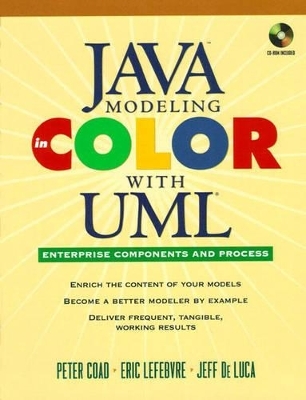
Java Modeling In Color With UML
Prentice Hall
978-0-13-011510-2 (ISBN)
- Titel ist leider vergriffen;
keine Neuauflage - Artikel merken
PLEASE PROVIDE
This is the first book to teach software design in color. Peter Coad and his co-authors use four colors to represent four "archetypes": forms that appear repeatedly in effective component and object models. Given a color, you'll know the kind of attributes, links, methods, and interactions that class is likely to have. Using these color "building blocks," you can build better models for any business. Coad's team plugs these archetypes into a 12-class domain-neutral component that reflects his unparalleled modeling experience. The book delivers 47 ready-to-use, domain-specific components, each designed to help you build better models and apps. Finally, the authors introduce Feature-Driven Development, a new process for getting the most out of Java modeling and development. It's like having Peter Coad at your side, guiding you towards more effective design!
Peter Coad is one of the world's most experienced model-builders, having created hundreds of models in nearly every industry. His company, Object International, delivers workshops, mentoring, and software. >Eric Lefebvre has spent many years developing enterprise-wide generic models, and developing methods, techniques, and tools for reusing them. He is Director of Research at Progestic Software in Montreal, Canada. Jeff De Luca's IT consulting practice, Nebulon Pty Ltd., specializes in enterprise-wide and system-wide architecture and Java development.
1. Archetypes, Color, and the Domain-Neutral Component.
Archetypes. Color. The Four Archetypes in Color. Given a Class, What's the Color, What's the Archetype? The Domain-Neutral Component. Interactions Within the Domain-Neutral Component. Component Connectivity. Twelve Compound Components. Suggested Reading Paths. Summary.
2. Make or Buy.
Material-Resource Management. Facility Management. Manufacturing Management. Inventory Management.
3. Sell.
Product-Sale Management. Cash-Sale Management. Customer-Account Management.
4. Relate.
Human Resource Management. Relationship Management.
5. Coordinate and Support.
Project-Activity Management. Accounting Management. Document Management.
6. Feature-Driven Development.
The Problem: Accommodating Shorter and Shorter Business Cycles. The Solution: Feature-Driven Development. Defining Feature Sets and Features. Establishing a Process: Why and How. The Five Processes within FDD. Chief Programmers, Class Owners, and Feature Teams. Tracking Progress with Precision. Summary and Conclusion.
Appendix A: Archetypes in Color.
Appendix B: Modeling Tips.
Appendix C: Notation.
Index.
| Erscheint lt. Verlag | 21.7.1999 |
|---|---|
| Verlagsort | Upper Saddle River |
| Sprache | englisch |
| Maße | 209 x 262 mm |
| Gewicht | 932 g |
| Themenwelt | Informatik ► Programmiersprachen / -werkzeuge ► Java |
| Informatik ► Software Entwicklung ► UML | |
| Mathematik / Informatik ► Informatik ► Web / Internet | |
| ISBN-10 | 0-13-011510-X / 013011510X |
| ISBN-13 | 978-0-13-011510-2 / 9780130115102 |
| Zustand | Neuware |
| Haben Sie eine Frage zum Produkt? |
aus dem Bereich


